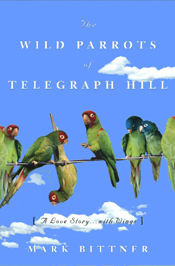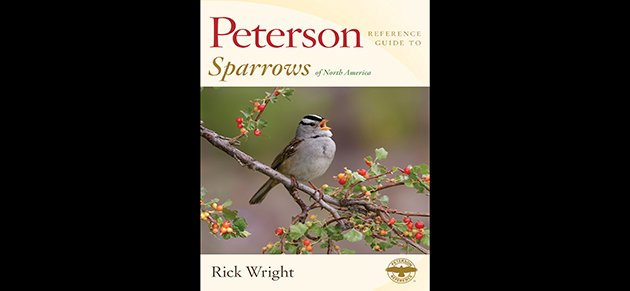 The Wild Parrots of Telegraph Hill by Mark Bittner is subtitled A Love Story… With Wings. Verily, there is truth in advertising. This fresh autobiographical study in amateur ornithology may be one of the first birding romance novels!
The Wild Parrots of Telegraph Hill by Mark Bittner is subtitled A Love Story… With Wings. Verily, there is truth in advertising. This fresh autobiographical study in amateur ornithology may be one of the first birding romance novels!
The Wild Parrots of Telegraph Hill is described as “the inspiring story of how one man found his life’s work and true love among a gang of wild parrots roosting in one of America’s most picturesque urban settings. The author is a San Francisco denizen most charitably described as aimless. His co-stars, on the other hand, know exactly where they’re going. The wild parrots of Telegraph Hill are an assortment of released and escaped pets, primarily cherry-headed conures (Red-masked Parakeet or Aratinga erythrogenys). As the book progresses and the flock grows, readers learn all about how these intelligent, incredible birds thrive in the alien ecosystem that is the Bay Area. The flock dynamic, as observed by Bittner, is fascinating; over a period of years, he chronicles births, deaths, illnesses, injuries, couplings, break-ups, and battles. Amidst this perpetual chaos, the one constant is Bittner’s deep affection for his feathered friends. This Bohemian St. Francis truly loves his birds.
Let me be honest-this was not the easiest book to finish. There were many points where I was so distracted by the author’s desperate existence that I lost patience with the narrative. My experience would have been much richer had I known about Bittner’s excellent supporting website. The Parrot Pages, with individual Bird Biographies, detailed notes, and striking color photos, bring each character to vivid life. I am glad that I completed the story, however, and not just because it has a happy ending.
This charming study of human-parrot relations was also turned into a feature-length, 16 mm documentary. This film, the work of Emmy-award winning director Judy Irving, was four and-a-half-years in the making and showered with accolades by the viewing public. I’m going to continue that trend. Though I missed the film in theaters, I viewed an advance copy of the DVD. What struck me was how different the two works titled The Wild Parrots of Telegraph Hill are. Irving’s film is just as charming as Bittner’s book, but for different reasons; the latter focuses on the birds while the former is all about the bird lover.
This dichotomy is essential in appreciating the complex narrative at work, each different medium used to explore a different facet of a tale that is only superficially about parrots. Make no mistake, this story is not meant for bird watchers alone. In fact, many hardcore birders may be put off by the glorification of an invasive species. Naturalist or not, any viewer would do well to put aside preconceptions and see The Wild Parrots of Telegraph Hill for what it is. This story, as a film or a book, is a dear romance. Love is the thread that connects its characters, human and avian alike.
Though love alone is powerful enough to sustain a story, this one is about more than that. Wildness, the idea of having to adapt to unfamiliar, possibly even dangerous surroundings in the struggle to survive, is another central theme. The first, overriding responsibility of a living being must be to live, to continue on despite adversity. That act alone takes enormous will when an organism finds itself in an environment to which it is not suited. This story is about survivors, and not just the feathered variety.
Adversity and adaptation, loss and love. The Wild Parrots of Telegraph Hill has it all. This story grows more interesting as one approaches it from different angles. Of all the avenues of engagement, the film is probably the most accessible, but with a DVD, a book, and various websites, there’s a way in for everyone. My recommendation is to explore this narrative for yourself; you can start with the trailer for the film.




 New writers welcome – please contact us for details.
New writers welcome – please contact us for details.

















We occasionally get updates on the Bittners (he is still married to the lady that filmed the movie) in parrot magazines and via parrot networks. As I remember he relinquished his familiarity with the parrots in the park in San Francisco, and now admires them more from a distance. As they became more tame and interacted with more people, the human element in their lives became in some cases problematic to the wild parrots. Cities have lots of exotic plants and trees now in the U.S. and there are more parrot flocks, some from as long back as the early 60’s. Some birds may be moving north naturally as the climate warms and their local Mexican nest sites are being destroyed by deforestation. The Parrot Trust is attempting to save some of the nesting sites by going as far as re-standing cut down trees with nesting holes and even parrot families intact. A beautiful story can be found on line today called “The Little Parrot.” It’s an ancient tale about a forest fire in India, which the Little Parrot tries to put out by carring water in his beak from the river over the fire area. Evntually Garuda the giant king of the birds sees the small parrot flying into the danger zone in an attempt to put out the fire…I think we are all like that small parrot and feel our own efforts at conservtion no matter how small will one day make a difference. Some parrots, like the Carolina Paraquette from our early U.S. colonization period, are already becoming extinct. The last Carolina pair lived in a zoo — supporting our zoos may help save some species as well as preserving the world’s forest. Trees are everyone’s friends — they even prevent flooding by their underground root systems absorbing water in the earth. Best and keep parrots in our prayers, Kathleen